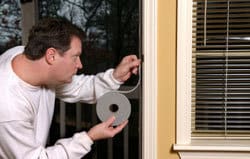 Your home's indoor temperature is affected by many things. First there's the weather outside. How often are you surprised when your home is nice and cool indoors while the outdoor temperature is heating up? Your home stays cool (or warm) because of the multiple layers that make up your home's skin. Similar to how your body's skin protects you from the elements, the skin of your house protects it from rain, wind and the flow of air between indoor and outdoor spaces, to maintain your desired temperature.
Your home's indoor temperature is affected by many things. First there's the weather outside. How often are you surprised when your home is nice and cool indoors while the outdoor temperature is heating up? Your home stays cool (or warm) because of the multiple layers that make up your home's skin. Similar to how your body's skin protects you from the elements, the skin of your house protects it from rain, wind and the flow of air between indoor and outdoor spaces, to maintain your desired temperature.
Federal Tax Credits to Shrink Heat Loss
There are Federal Tax Credits available through year end 2010, for your “principal residence“. The credit has a cap of $1,500 for all products installed from January 1, 2009 through December 31, 2010. You need a Manufacturer’s Certification Statement, a signed statement certifying the product qualifies for the tax credit. You should be able to find this documentation on the web or by calling the manufacturer. All receipts and supporting documentation should be saved for your records although they do not need to be submitted with IRS form 5695, Residential Energy Credits. Most products require professional installation. Some like insulation and weather stripping can be installed by home owners. The table below identifies which products can claim a credit for installation costs, i.e. labor costs for installing insulation are not eligible for the tax credit even though blown-in insulation should only be installed by experienced professionals.
Note: You might also like our article on Home Products that Burn More Efficiently
| Home Products that Reduce Heat Loss | % Tax Credit | Install Costs | Expiration Date |
| Bulk insulation (batts, rolls, blow-in fibers, rigid boards, expanding spray, pour-in-place or spray foam in a can) | 30% | No | 12/2010 |
| Home sealing products like weather stripping and house wrap, help reduce air flow | 30% | No | 12/2010 |
| Any roofing product that meets ENERGY STAR qualifications for solar reflectance (achieved through pigmented coatings, cooling granules and other new technology) | 30% | No | 12/2010 |
| All windows that meet ENERGY STAR qualification (U factor <=0.30 and SHGC <=0.30) | 30% | No | 12/2010 |
| All doors, including patio doors, French doors that meet ENERGY STAR qualification as windows (U factor <=0.30 and SHGC <=0.30). Some garage doors may also qualify. | 30% | No | 12/2010 |
| Storm doors/windows must in combination with the exterior windowver which it is installed, meet same the same criteria (U factor <=0.30 and SHGC <=0.30). | 30% | No | 12/2010 |
Insulation
Insulation is useful throughout your home. Exterior walls should be sealed from the foundation to the roof peak, closing all gaps between the different materials to minimize air flow. Inside your home, there are many opportunities to reduce heat loss around doors, windows and electrical outlets/switch plates on exterior walls. With forced hot air systems you should make sure air ducts are sealed to prevent heat loss, and then wrap them with insulation too.
You can also wrap all accessible plumbing that carries hot water, to reduce heat loss to reduce the amount of fuel being burned to deliver hot water to your home for heat and/or hot water. There are insulating blankets to wrap your hot water heater and many different kinds of foil and foam insulating tape.
When a basement or attic is unfinished, you can add insulation to the floor/ceiling that butts up to heated space.You should also insulate the door used to access the attic, both the door panel and use a kit with instructions for sealing the gaps around the door where lots of heated/cooled air can flow easily.
Energy Efficient Roofing
With air conditioning using one sixth of all electricity generated in the US, it is important to find ways to reflect sunlight and reduce the demands placed on our air conditioning systems. New roofing materials capable of reflecting sunlight are coming on the market and should be considered when replacing an existing roof or during new construction. There is a Roof Savings Calculator to help you decide if this is a good investment for your home and family.
Energy Efficient Windows and Doors
Windows and doors combined represent the second largest surface area in your home's exterior. They include both materials and the structural framing that doors and windows sit in. A common problem is a lack of insulation in the narrow slots between the window and the rough opening so a cold window isn't just cold because of the glass, it can also be cold when there's no insulation in the wall immediately surrounding the window.




Leave a Reply